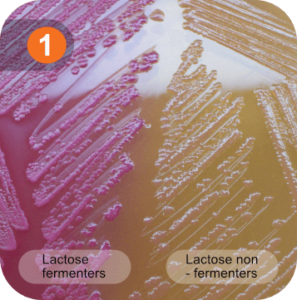


Sodium chloride is removed from the medium to provide an electrolyte deficient medium preventing Proteus spp from spreading. coli O157: H7 sorbitol negative (source: Color Atlas of Medical Bacteriology 4ed) ◉ 2- MacConkey without crystal violet and salt MacConkey with sorbitol : on the left an E. Gram negative bacteria that thrive on MacConkey agar but do not ferment lactose appear colorless on the medium and the agar surrounding the bacteria remains relatively transparent : Salmonella, Proteus, Yersinia, Pseudomonas.When the pH drops, the neutral red is absorbed by bacteria, which appear as bright pink to red colonies on the agar : Escherichia coli, Enterobacteria, Klebsiella Bacteria which ferment lactose decrease the pH of the medium, this decrease is detected by neutral red(become red if pH below 6.8).Gram-negative bacteria that grow on MacConkey plate are differentiated by their ability to ferment lactose. This only allows gram-negative species, which have a relatively bile-resistant outer membrane, to form colonies on MacConkey agar. ◉ Selectivity of MacConkey agarĬrystal violet dye and bile salts stop the growth of gram-positive bacteria. In particular members of the Enterobacteriaceae family and the genus Pseudomonas. ◈ MacConkey Agar is a selective and differential medium used for the isolation and differentiation of non-fastidious Gram-negative bacilli, ◉ Principle and interpretation of MacConkey agar ◈ A variant of MacConkey agar without crystal violet and salt can be used to limit the swarming of Proteus spp. ◈ The lactose in the medium can be replaced by other sugars : MacConkey with sorbitol.


 0 kommentar(er)
0 kommentar(er)
